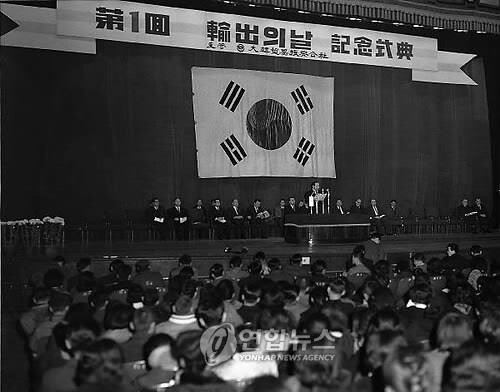From Wig Seller to High-Tech Manufacturing Powerhouse... Korea's …
페이지 정보
작성자 발리한국센터 쪽지보내기 메일보내기 홈페이지 자기소개 아이디로 검색 전체게시물 작성일24-09-13 09:03 조회166회 댓글0건관련링크
본문
박정희 정부는 전후 최빈국인 한국으로선 수출만이 살 길이라고 보고 구로공단을 중심으로 한 수출 드라이브를 강력하게 걸었다. 특별한 기술도 자본도 없던 당시 가발, 다람쥐 등 돈 되는 것은 모두 세계 시장에 내다 팔면서 1964년 수출 1억달러를 처음으로 달성했다. 이후 1960∼1970년 연평균 수출 증가율은 40%에 달했다.
Park Chung-hee's government saw exports as the only way forward for Korea, the poorest country in the postwar era, and launched a strong export drive centered on the Guro Industrial Complex. With no special technology or capital, the country sold wigs, squirrels, and anything else that was profitable to the world market, reaching $100 million in exports for the first time in 1964. From 1960 to 1970, the average annual export growth rate reached 40%.
연간 기준 1970년 10억달러, 1977년 100억달러, 1995년 1천억달러, 2011년 5천억달러를 돌파한 수출은 올해 사상 최초로 '7천억달러' 달성 목표까지 눈앞에 두고 있다.
Exports, which topped $1 billion in 1970, $10 billion in 1977, $100 billion in 1995 and $500 billion in 2011 on an annualized basis, are on track to reach the "$700 billion" mark for the first time ever this year.
1964년 1억달러에서 시작한 수출이 60년 만에 7천배 가까이 뛴 것이다. 서울 구로공단에서 시작한 산업단지는 현재 전국 1천300여개로 확장해 약 12만개 기업과 200만명이 넘는 근로자들의 삶의 터전이 됐다. 산업단지는 전체 제조업 중 생산액 60.6%, 수출액 65.1%, 고용 47.9%를 담당하면서 한국 경제의 심장부 역할을 하고 있다.
From $100 million in 1964, exports have grown nearly 7,000-fold in 60 years. Starting in Guro Industrial Complex in Seoul, industrial parks have expanded to more than 1,300 nationwide and are home to nearly 120,000 companies and more than 2 million workers. Industrial complexes are the heart of the Korean economy, accounting for 60.6% of total manufacturing output, 65.1% of exports, and 47.9% of employment.
출범 60주년을 맞은 산업단지는 인공지능(AI), 데이터 산업 등 글로벌 첨단산업 확장의 흐름과 발맞춰 데이터의 연결·공유를 통한 제조와 인프라 혁신 등의 전환을 꾀하고 있다. 정부는 2019년 창원, 반월·시화산단을 시작으로 올해 18개 산단을 스마트그린산단으로 지정했다. 오는 2027년까지 스마트그린산단을 25개 산단으로 늘리는 게 정부 국정과제다.
The industrial complex, which celebrated its 60th anniversary, is trying to transform manufacturing and infrastructure innovation through data connection and sharing in line with the expansion of global high-tech industries such as artificial intelligence (AI) and data industry. The government designated 18 industrial complexes as smart green industrial complexes this year, starting with Changwon, Banwol, and Sihwa Industrial Complexes in 2019. It is the government's national task to increase the number of smart green industrial complexes to 25 by 2027.
안덕근 산업부 장관은 "산업단지의 역사가 곧 대한민국의 눈부신 경제성장의 역사라 해도 과언이 아니다"라며 "앞으로 산업단지를 첨단·신산업의 거점이자 청년이 찾고 머물고 싶은 산업과 문화의 융합 공간으로 재창조해 나갈 것"이라고 밝혔다. 이상훈 한국산업단지공단 이사장은 "산업단지는 보다 젊어지고 활력이 넘치는 공간으로 변모해 가고 있다"며 "단순한 제조 생산을 넘어 첨단 기술과 창의적 아이디어가 융합되고, 일터와 삶터가 유기적으로 연결된 산업단지를 만들어 나가겠다"고 말했다.
"It is no exaggeration to say that the history of industrial complexes is the history of Korea's remarkable economic growth," said Ahn Deok-geun, Minister of Trade, Industry and Energy. "We will continue to reinvent industrial complexes as a base for cutting-edge and new industries and as a convergence of industry and culture where young people want to live and work." "Industrial complexes are transforming into younger and more energetic spaces," said Lee Sang-hoon, Chairman of Korea Industrial Complex Corporation. "We will go beyond simple manufacturing production to create industrial complexes where advanced technology and creative ideas are fused, and where work and life are organically connected."
[연합뉴스 제공]
[Courtesy of Yonhap News Agency]
Translated by OpenL

 BALI 한국센터
BALI 한국센터
 BBJA 농구단
BBJA 농구단
 재인니 한인 야구 협회 (Indonesia Korean Baseball Organization ; IKBO)
재인니 한인 야구 협회 (Indonesia Korean Baseball Organization ; IKBO)
 UMN BIPA
UMN BIPA
 인도네시아 국립대(UI)
인도네시아 국립대(UI)
 코리아나 야구동호회
코리아나 야구동호회
 FC화풋
FC화풋
